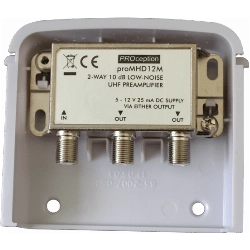1-Way UHF High Gain Masthead Amplifier
Product Code: PROMHD11H
- High gain masthead amplifier
- F-Type connections
- 1 input, 1 output
- Suitable for outdoor use
Product Description
High Gain (27dB) UHF Masthead Amplifier for 1 TV
Do you have problems with poor TV signal, and wondered how to boost reception?
Our high performance, masthead amplifiers are ideal for boosting your UHF TV signal. They are extremely low-noise (reduced interference) offering better signal quality.
How do I install my UHF amplifier?
Masthead amplifiers are installed externally in a robust weather-proof casing, which slides up to reveal the amplifier. This is typically installed on the aerial pole.
It also requires a power supply which can be bought separately or as a kit. The power supply is installed behind one of the TVs in the system. Simply install the power supply inline with the cable and plug it in to a mains socket. It then sends power up the cable to the masthead amplifier. This is ideal if you cannot install a distribution amplifier in the loft due to lack of a mains socket. Please note: any 5-12V source can be used instead of a power supply.
Features:
- Fully-screened masthead amplifiers with 'F' connector (screw on) outputs. Which means less interference caused by passing vehicles or other strong signals the F connectors ensure the lowest loss on a weak signal and screw on for a secure connection.
- Low noise figures and well-filtered inputs. Low noise figures help because on a weak signal you already have lots of noise and the last thing you want an amplifier to do is add more noise to it.
- Sharp cut off below 400MHz, helps avoid interference problems from nearby transmitters: CB, PMR, TETRA, HF and VHF amateur radio, etc.
- Variable gain models have inter-stage control to maintain good noise figure at reduced gain. Variable gain means you can adjust the amount of amplification required to either boost your signal.
- With equipotential bonding point. This is to allow you to earth the amplifier and help discharge static electricity.
Technical Information:
Product Code | Ways | *Gain | *Noise Figure | *Max Input | *Power Requirement | Typical Applications |
PROMHD11L | 1 | 9dB | 1.8dB | 80dBV | 5 - 12V, 25 mA | Margin raising preamplifier |
PROMHD11M | 1 | 16dB | 1.7dB | 75dBV | 5 - 12V, 25 mA | For weaker signal areas |
PROMHD11H | 1 | 27dB | 1.8dB | 74dBV | 12V, 50 mA | Long downleads, splitters |
*Gain: This is the amount of amplification the amplifier can provide and the higher the number the more it will boost your signal.
*Noise figure: Low noise figures help because on a weak signal you already have lots of noise and the last thing you want an amplifier to do is add more noise to it.
*Max Input: The maximum amount of signal the amplifier can safely handle on the input from the transmitter/aerial.
*Power requirement: The power supply’s required voltage and ampage to drive the amplifier.
The maximum output level per multiplex is per the table in dBV when there are eight equal level multiplexes. If the number of multiplexes to be carried is not eight please refer to our Mux guide.
Technical Specification
IEC or F Type
F-Type
Number of Outputs
1
Number of Inputs
1
Low, Medium or High
High (27dB)
Internal or External
External
Amplifier Includes Power Supply Unit (PSU)
No
Amplifier Includes Full Output
No
Product Requires Power Supply Unit (PSU)
No
RED Class 0 or Class 1
Class 0
Width
97mm
Depth
68mm
Height
118mm
Weight
0.19kg
03/10/2025
01/10/2025
Delivered on-time without hitch.
25/09/2025
Excellent
23/09/2025
All good
14/09/2025
Spot on with everything needed good
Google Company Reviews
05/12/2025
Initially wrong products were picked and despatched. Replacements sent as soon as I made contact. Eventually good service
02/12/2025
Had to ring to see why I hadn't received my order, was told one item was out of stock, said they didn't know when they would receive the item but that same day it was sent to the courier, then still took another four days before I received my package,very poor packaging,hard to get into, one pole badly scratched and the other has a sticker on it that I cannot remove.
28/11/2025
Excellent, fast service and the aerial pole arrived in 100% condition.
22/11/2025
04/11/2025
item not received after a number of days. Reported by landline to Blake Head Office this morning.. Request replacement at no expense to myself. Please advise. Thanks. Anthony Ernest.








 Quick Add
Quick Add













Exactly what I needed and delivered when said great team